Cooking and Sharing Iraqi Jewish Food Helps Me Imagine a Place I Never Knew
Food preserves the story of the Iraqi Jews, a story of starting over.
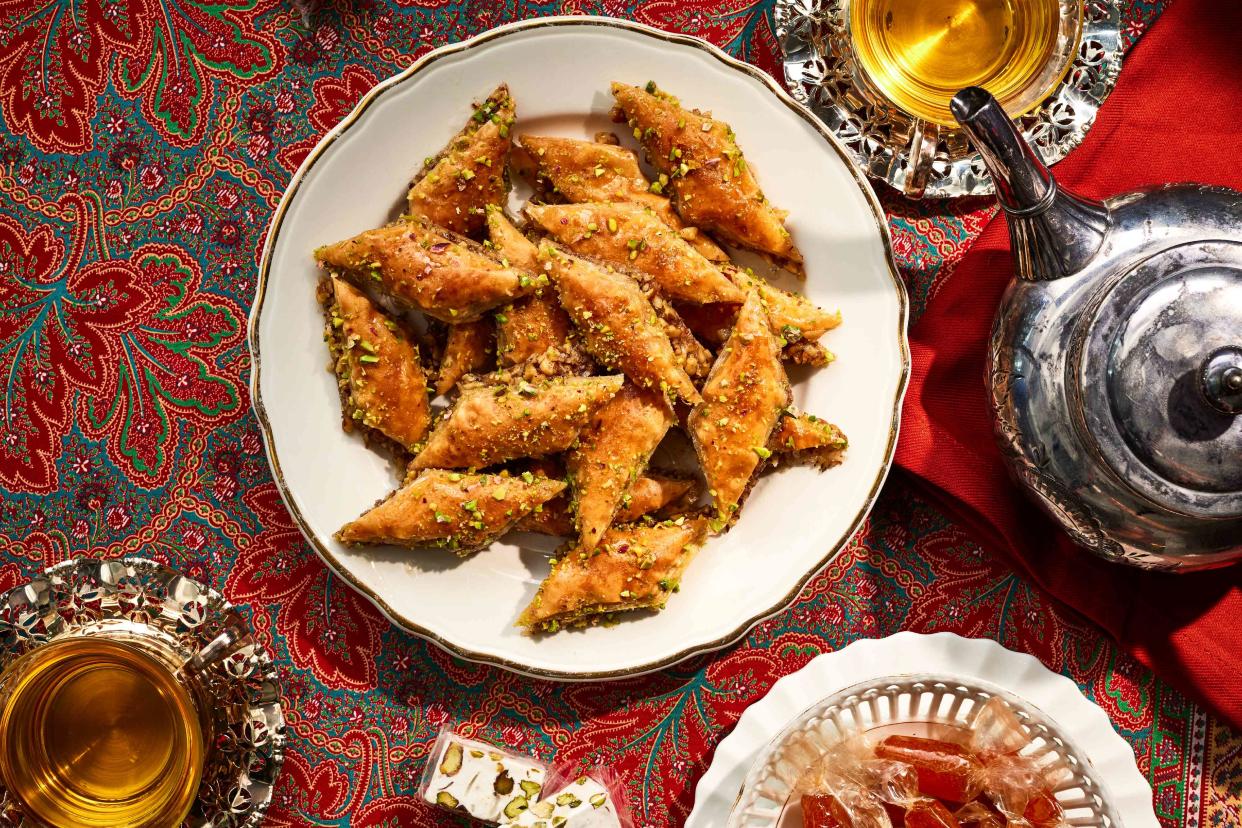
Victor Protasio / Food Styling by Chelsea Zimmer / Prop Styling by Christina Daley
My grandmother’s kitchen was on the Upper East Side, but it tasted of Iraq.
As Ama brushed butter onto sheets of phyllo dough, she’d share stories of her girlhood in Baghdad. “We’d swim in the Tigris with water buffalo,” she’d say with delight at my amazement, each layer of pastry unfurling more memories. “To escape the summer heat, we’d sleep on the flat rooftops in the cool night air.” She’d yell to my grandfather in the living room in Arabic, give my dad instructions in French, and speak politely to my measured Methodist mother in English, but to me, she spoke loving words that needed no translation; she’d call me ayuni (my eyes) and qalbi (my heart). I’ll never know my Ama’s verdant, cosmopolitan Baghdad, in the region my ancestors called home for 2,500 years. But in her kitchen, I could taste it.
The food of the Iraqi Jews tells our story. M’hasha is about community. The project of coring vegetables, stuffing them with herbed rice, and stewing them in tangy tamarind is made quick by many hands. Tebit is a distinctly Jewish dish. Traditionally made to feed dozens of family members on the Sabbath, the spiced chicken and rice are placed in the oven on Friday night and cooked overnight on low through Saturday. Whole eggs are placed on the top to bake for a Sabbath breakfast, and the rice is still warm by dinner. Kubba Patata, lamb-stuffed potato patties redolent with curry powder, recalls the centuries of successful trade between Baghdad and the Indian cities of Kolkata and Mumbai. Baklava is the sweet made for massive family weddings — a celebration calls for shelling hundreds of pistachios.
To me, the spirit of the Iraqi Jews comes most alive in the simplest of dishes, like Bamia, okra stewed in sweet-and-sour tomato sauce. Where other cultures have mother sauces, we have lemon and sugar. Intense yet balanced, bamia gets its flavor from a combination of the two — a combination that expresses the history of the Iraqi Jews, both its sweetness and its bitterness.
Related: 33 Middle Eastern Recipes Featuring Feta, Phyllo, and Fragrant Spices
The story of the Iraqi Jews is a tale of two exiles: the first, when Nebuchadnezzar II destroyed the First Temple in Jerusalem around 587 B.C., and the second, beginning after World War II, when the Jews were expelled from Iraq. The Jews who traveled to Babylon as captives and exiles began the community that would thrive for centuries as Babylonian, Mesopotamian, or Mizrahi Jews. “By the rivers of Babylon we sat and wept ... How can we sing the Lord’s song in a foreign land?” asks the writer of Psalm 137. For more than 2,500 years, the Iraqi Jews did just that in the city known since the eighth century as Baghdad.
Baghdad’s Jewish community prospered in business, trade, and government, most notably under the Ottoman Empire. The Sassoons, my grandfather’s family, were among the most influential, establishing global trade routes between India, China, and Britain. With the fall of the Ottoman Empire in the early 20th century, everything changed. As my grandfather Abdallah Simon writes in his memoir, Vintage Years, “The establishment of an independent state of Iraq following World War I effectively marked the beginning of the end for Iraqi Jews. The fact that they are virtually non-existent in Iraq today is a sad footnote after over two millennia of thriving.” Fueled by rising Arab nationalism and Nazi propaganda, hundreds of Baghdadi Jews were massacred in June 1941 in a multiday pogrom called the Farhud; homes were pillaged and communities ravaged.
My grandfather became a lieutenant in the Iraqi army soon after and was able to travel to Rio de Janeiro by way of Tehran, Cairo, and Lisbon, where he took a boat to Philadelphia, securing one of the 150 U.S. visas available to Iraqis that year. In 1948, my grandmother attempted to flee over the Zagros Mountains in the north of Iraq by dressing as a nun; she was caught but eventually escaped later that year hiding under a sheet in the back of a family car on a drive into Iran. A small number of Jews (including Doris Zilkha, who developed the recipes that follow) lived there into the 1970s, when they were pushed out as Saddam Hussein came to power in 1979. Today, the Jewish population of Baghdad can probably be counted on the fingers of one hand.
Related: The Jewish American Bakery Renaissance Is in Full Swing
Those who made safe passage planted new roots in places like Israel, London, Montreal, and New York. My grandfather joined the wine business, founding Chateau & Estate, a fine wine importer later acquired by Seagram. My childhood memories include tastes of his French wines paired with my grandmother’s Iraqi food served on green-and-white-painted Perrier-Jouët plates. On the most special occasions, he would open bottles of Perrier-Jouët’s Belle Époque or Château Lafite Rothschild. At Shabbat dinners, he would say the kiddush over glasses of Trimbach Pinot Gris.
“How can we sing the Lord’s song in a foreign land?” The question still resounds. Cooking is like singing. It’s a way of remembering, safeguarding, and celebrating; it’s a form of praise. For many diasporic communities, it’s a way of connecting. Cooking, eating, and sharing Iraqi Jewish food, now without my grandparents, who have been gone for over a decade, has helped me imagine a place I never knew, but a place that is a part of me. I’ll never know their Baghdad, but I can taste it.
M’hasha (Sweet-and-Sour Stuffed Vegetables)
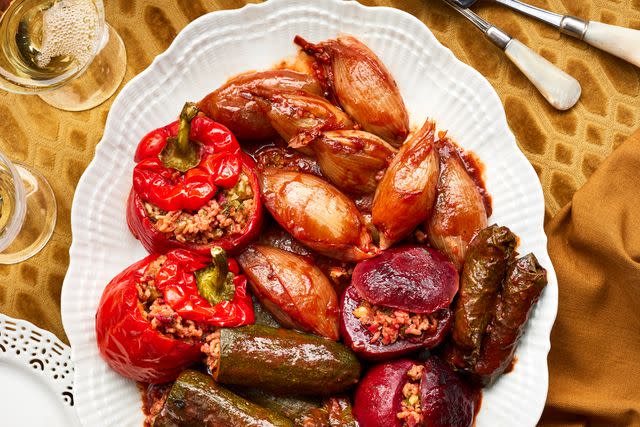
Victor Protasio / Food Styling by Chelsea Zimmer / Prop Styling by Christina Daley
Vegetables stuffed with herbed rice are tucked into a Dutch oven and baked in a tangy tomato-tamarind sauce. This dish takes time to put together, but nothing is difficult to do, and several components lend themselves to advance prep.
Tebit (Chicken Baked in Rice)
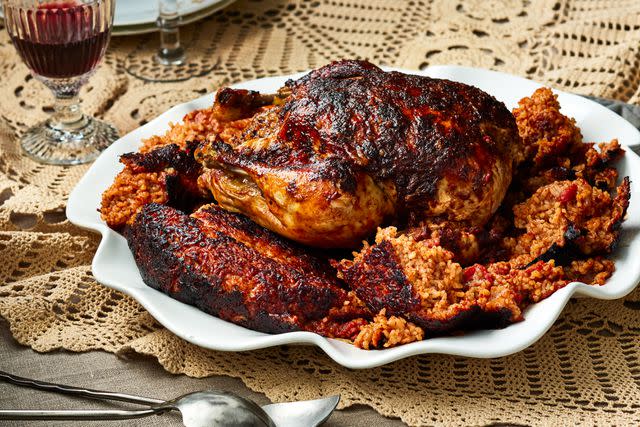
Victor Protasio / Food Styling by Chelsea Zimmer / Prop Styling by Christina Daley
A whole chicken cooks in a bed of tomatoey, tender, spiced rice in this one-pot Iraqi Jewish dish. Tebit is often made for Shabbat, the Jewish day of rest, because it can be prepped and cooked the night before. To serve, the pot is flipped over to release the rice, which caramelizes on the bottom and along the edges, creating a crunchy and dramatic crust.
Kubba Patata (Lamb-Stuffed Potato Patties)
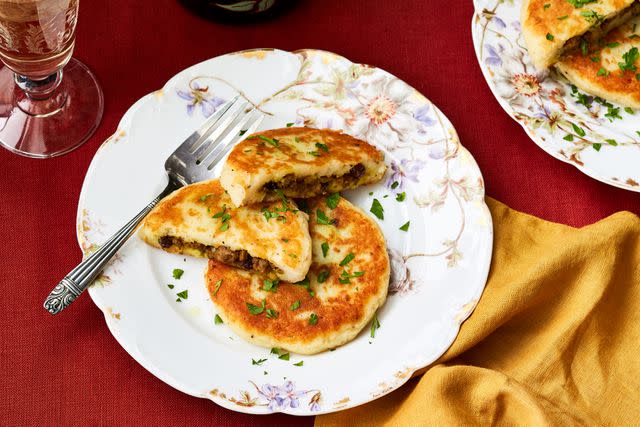
Victor Protasio / Food Styling by Chelsea Zimmer / Prop Styling by Christina Daley
Kubba patata (fried potato patties) are a satisfying snack. A filling of curry-spiced lamb, pine nuts, and raisins makes these bites especially rich and comforting.
Bamia (Okra Stewed in Tomato Sauce)
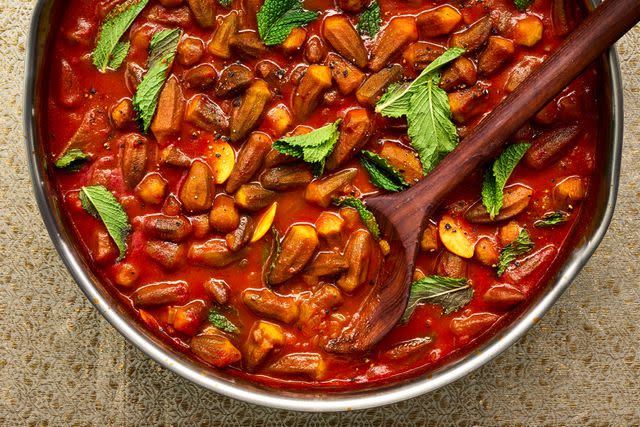
Victor Protasio / Food Styling by Chelsea Zimmer / Prop Styling by Christina Daley
Bamia means “okra” in Arabic, and in this side dish, the vegetable is stewed in a savory tomato sauce. The variety of okra indigenous to Iraq is petite compared to most grown commercially in the U.S., so to make this dish, look for tiny frozen okra pods at Middle Eastern markets; they hold their shape well and release very little liquid.
Iraqi Baklava
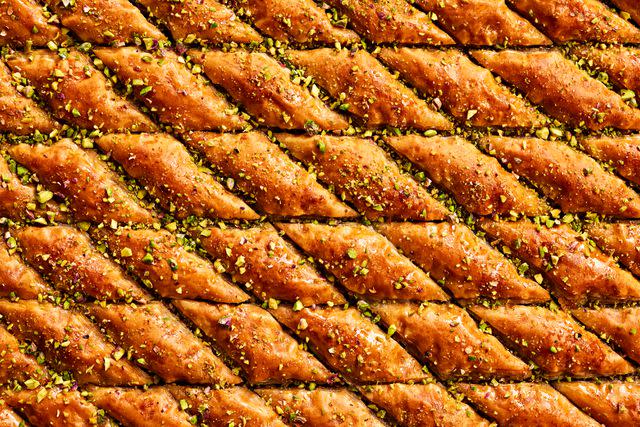
Victor Protasio / Food Styling by Chelsea Zimmer / Prop Styling by Christina Daley
This recipe differs from Greek and Mediterranean styles of baklava, where honey is used to saturate the pastry. Iraqi baklava is soaked and flavored instead with a homemade light sugar syrup that’s subtly flavored with rosewater and lemon juice for a sweet, floral, and slightly tangy finish to the nutty pastry.
Honoring a Heritage
Cook
Oded Halahmy left Baghdad in 1951 and worked as a multimedia sculptor between New York and Jaffa, Israel. He remembers Iraq mostly through his art, but in 2022, he published a cookbook titled Iraqi Cooking: Exile Is Home, which includes his own recipes for dishes like kibbeh and cheese-filled sambusak. Daisy Iny, a distant cousin of my grandmother, published the first Iraqi cookbook made for U.S. home cooks called The Best of Baghdad Cooking with Treats from Teheran in 1976. While few copies remain (you can sometimes find them on Amazon), the book has served as a touchstone for myself and other Iraqi Jewish cooks, and it is well worth snapping up if you find a copy.
Learn
Edited by Tamar Morad, Dennis Shasha, and Robert Shasha, Iraq’s Last Jews: Stories of Daily Life, Upheaval, and Escape from Modern Babylon is a book of oral histories of the last generation of Jews who lived in and escaped from Iraq. The stories are poignant, personal, and brave but chronicle the everyday, too — like how a mother would shop for a group of 30 at the market or how families preserved dates in summer. Mizrahi Jews are from all around the Middle East and North Africa. Follow Ciara Shalome’s Instagram account @themizrahistory for oral histories of Mizrahi Jews from Iraq, Egypt, Yemen, Tunisia, and beyond.
Grow
The Iraqi Seed Collective is a global organization that seeks to preserve Iraqi heritage through the genetic legacy of crops by saving and sharing heirloom seeds of Iraqi produce varieties. “The thing about seeds is that you can eat and share the fruit and save more seeds as you grow,” says Ali Ruxin, a founding member. “In the context of our history, there’s something so hopeful about seeds.” Follow @iraqiseedcollective on Instagram, and join the collective to learn more about growing plump fava beans, tender okra, and fragrant melons.
For more Food & Wine news, make sure to sign up for our newsletter!
Read the original article on Food & Wine.






